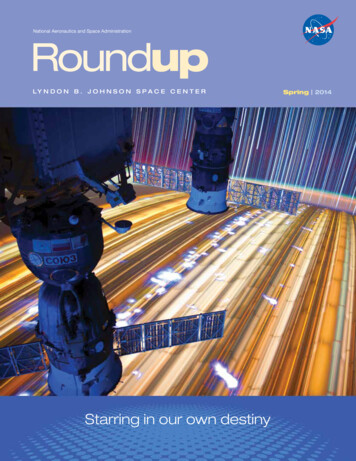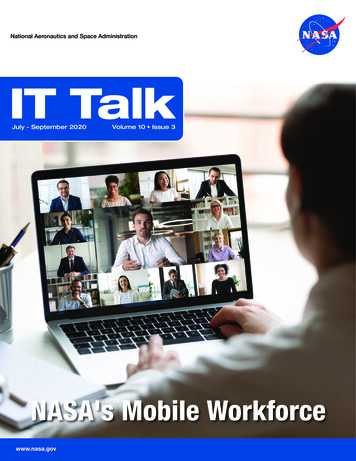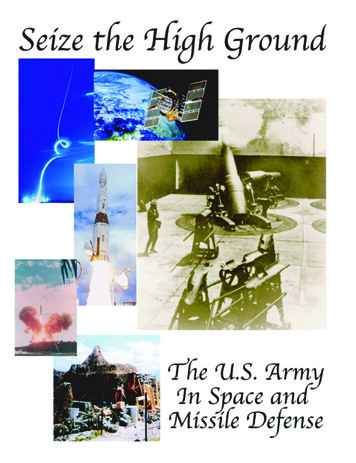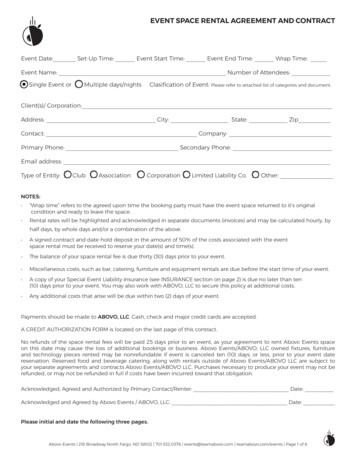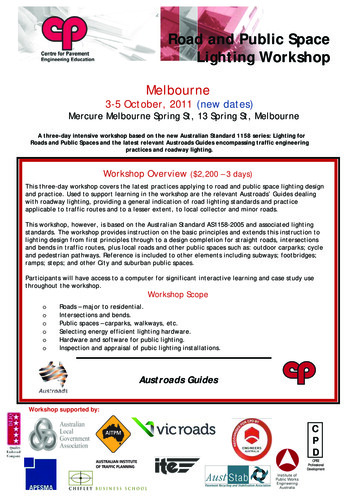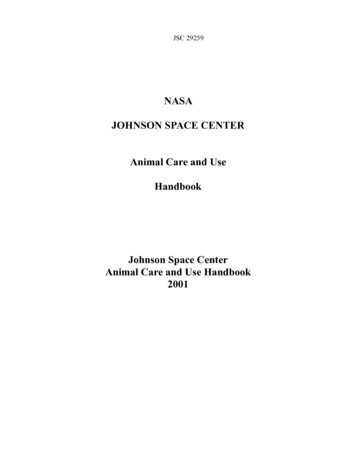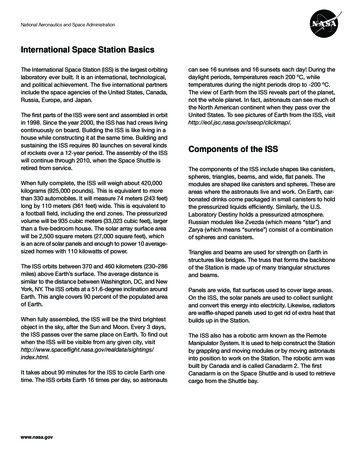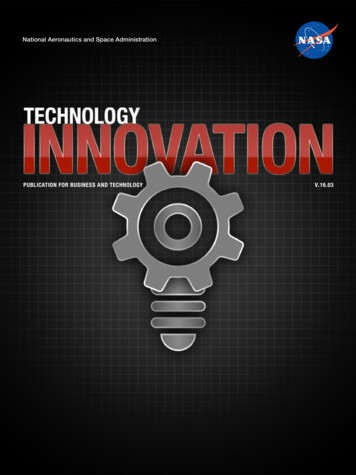
Transcription
National Aeronautics and Space AdministrationPUBLICATION FOR BUSINESS AND TECHNOLOGYV.16.03
A Message from theAssociate Administrator of theSpace Technology Mission DirectorateDear Colleagues,For much of its history, NASA has been engaged in the study and development of robotsto enhance the Nation’s exploration endeavors.NASA robotic systems serve a variety of functions and seek to enable many differentkinds of missions in space. Robotic arms on spacecraft are used to move very largeobjects in space. The European Space Agency’s Rosetta probe recently landed on acomet, illustrating how robotic spacecraft can extend our reach and enable us to visitother worlds, planets, or celestial bodies. Rovers explore the surface of Mars and senddata back to Earth, facilitating study of the Red Planet’s habitability. Remotely pilotedrobotic airplanes, like the Ikhana unmanned aircraft system, which captured live videofeed of the descent of the Orion Exploration Flight Test 1 in early December 2014, canfly without a pilot on board.On Earth and in space, NASA is developing, testing, and flying transformative capabilities and cutting-edge technologies for a new future of collaborative human and roboticexploration. In this issue, we’ve highlighted technologies on board the InternationalSpace Station, which provides the astronauts with an ideal test bed for experimentation.We’ve also featured our continued development of the robotic Exoskeleton, a machinewith applications for astronauts working on the surface of distant destinations as wellas potential for helping with the physical rehabilitation of people here on our homeplanet.In addition to the successful developments in exploration robots, NASA also continuesto build public engagement in robotics that will benefit the American economy. TheNASA–Worcester Polytechnic Institute Sample Return Robot Competition, for example,seeks to solve technical challenges by mobilizing American ingenuity. This edition alsocontains examples of private companies and small businesses investing in NASA spinofftechnologies to develop robots and software that enhance safety, efficiency, and productivity in industries from healthcare to mining, from disaster relief to manufacturing.By leveraging partnerships with other parts of NASA, as well as with other governmentagencies, industry, and academia, NASA is playing a key role in advancing our use ofrobotic technologies—technologies that drive exploration.Cheers,Dr. Michael J. GazarikAssociate AdministratorSpace Technology Mission Directoratehttp://www.nasa.gov/spacetech
V.16.03 CONTENTSFEATURESROBOTS ONBOARDInternational Space StationIN THE WORKSDeep Space MissionsBIG STEPSThe Robotics IndustryA WALK IN THE PARKCentennial ChallengesSPINOFF HIGHLIGHTSBENEFITING BOTH MARS AND EARTHLogistics in HospitalsACTING, SENSING, REACTING, LEARNINGSpinoff SoftwareINSIGHTwith KIM HAMBUCHENRobotics EngineerJohnson Space Center
ROBOTSO N B O A R DThe International Space Station provides a unique platform foradvanced robotics projects that will open the door to a future of enhancedhuman-robot collaboration in exploration.
“The best robotics laboratoryin the solar system.” This is how RobAmbrose, principal investigator forNASA’s Game Changing DevelopmentProgram and chief of the Software,Robotics, and Simulation Division atJohnson Space Center, refers—withouthesitation—to the International SpaceStation (ISS). Orbiting more than 200 miles above Earth, the ISS is well knownas a scientist’s dream, providing a long-term microgravity environment forexperiments in areas from health and medicine to biology, botany, fluid mechanics,and nanotechnology. The ISS has also quickly become an ideal test bed fordeveloping some of the world’s most advanced robotics technology—technologythat is on the cutting edge in space exploration and on-the-ground research.“With the arrival of some of the latest robots, we’ve busted amyth about space robotics,” says Ambrose. “The mythwas that because it’s so hard to get things into space,by the time you do, it’s probably old technology.” ButAmbrose points out that the ISS currently hosts anarray of state-of-the-art robotics projects, includingmanipulators, human-scale dexterous robots, freeflying robots. These projects are not only enabling afuture of human-robot space missions, but promisingextraordinary benefits on Earth, as well.Putting the coolness factor aside, why do we need robotsfor space exploration? As the Curiosity rovermost recently demonstrated, roboticexploration missions can
provide invaluable scientific data and generate a lot of excitement among thepublic at large. Nevertheless, the big goal has always been for humans to traveldeeper into space, for actual people to set foot on Mars, for example. Ambroseexplains that robot technology will play a major part in making that happen.“We have a vision for how robots can fit into human exploration,” he says. Thefirst role is that of a scout: robots would be sent in advance of a human missionto ensure the destination is desirable. A second role would be as a crewmember:robots would support the human crew while in space. A final role would be in amaintenance capacity: robots would be left behind to monitor and repair a facilityor continue experiments after the human crew has left.“Imagine if we can park a facility on the surface of Mars with a robot caretakerand then, years later, launch a human crew to go meet it,” Ambrose says. “Thatwill make our exploration of the solar system more efficient and more flexible.The facility can be up and running for months or years so we know it can betrusted, that it is safe. When the human astronauts arrive, they would be able tofocus on jobs like exploring the Martian surface to make amazing discoveries.”The reality of space travel involves dirty, dull, and sometimes dangerous work towhich a robot would be well suited.Jobs like exploring theMartian surface“Over the years, I’ve asked people, if you had a robot, what would you want it todo for you?” Ambrose says. “Kids always say ‘Do my homework.’ Adults alwayssay ‘Clean the bathroom. Clean the kitchen.’ And when we ask astronauts, theywant the robot to do chores too.” Whether the task calls for measuring the airflowfrom a filter or navigating the risks of an emergency spacewalk, there are multipletasks involved in space travel that suit robots far better than humans. Robots do
not get tired or distracted by the beautyof Earth turning outside the window. And,as Ambrose notes, they can hold theirbreath for a very long time.WALK LIKE A ROBOTWith these benefits and more in mind,NASA has been developing generationsof a humanoid robot, dubbed Robonaut,since the late 1990s. Together with partnerGeneral Motors, NASA envisionedRobonaut as a robot that would notreplace people but work alongside them.“General Motors shared our vision of arobot that can safely work next to peopleand that can work with the same interfaces built for people. The whole point ofthe Robonaut system is that it’s going to be working near people and workingwith them safely,” Ambrose says.The second generation Robonaut, R2, made history as the first robot crewmemberof the ISS when it arrived at the Space Station in 2011. Possessing remarkabledexterity and designed to ultimately assist ISS crewmembers in maintaining theStation, R2 lacked a key part: legs. That changed this year when NASA partnerSpaceX delivered R2’s unique lower half to the ISS on Sunday, April 20.R2’s new legs are its least humanoid feature. With seven joints each and, insteadof feet, grasping “end effectors” equipped with camera eyes, R2’s legs are morereminiscent of tentacles than of human parts. Nevertheless, this new additionto the R2 allows it to move about inside the ISS and extend its assistive capabilitiesbeyond measuring the flow of air filters. Studies are under way to demonstrateR2’s potential to perform telemedicine—conduct ultrasound examinations and
administer medications while being remotely controlled by doctors on the ground.“We’re very excited that these legs will give R2 the mobility it needs to climbaround inside the Space Station,” says Ambrose, though he acknowledges thatR2 will hardly be swinging from module to module like a monkey. “It will alwaysbe required to have one foot down at a time, and it will move rather slowlythroughout the Station. But with a robot, what’s the rush?” Ambrose adds.Even as R2 is in the process of gaining its mobility, NASA and its partners areapplying technology derived from the Robonaut program—most recently, the R5robot—to help people on Earth regain theirs. NASA teamed with the Institute forHuman and Machine Cognition in Pensacola, FL, which had already beendeveloping exoskeleton technology to help people who had lost the ability towalk and required assistance moving. The collaboration, in a mere 9 months andwith a team of five to six people, resulted in the X1 exoskeleton based on Robonauttechnology. The team soon realized that not only could the X1 potentially allowpeople with physical injuries or neurological conditions to walk again, it couldalso be used to measure astronaut strength in space in order to assess theeffectiveness of exercise routines designed to combat the debilitating effects oflong-term living in microgravity.measuring astronautstrength in space“It just goes to show that when you do some research, sometimes it leads to anapplication that you would have never imagined,” Ambrose says.REMOTE POSSIBILITIESR2 is not autonomous; it is controlled either by ISS crewmembers or by researcherson the ground. Another pair of remotely controlled robot projects based on theISS are also adding to the possibilities of human-robot space exploration.
“At the most basic level, what we are trying to do is improve the way that humanscan live and work in space by using remotely operated robots,” says Terry Fong,director of the Intelligent Robotics Group at Ames Research Center. As with R2,Fong and his colleagues look at ways robots can take over repetitive, routinemaintenance tasks to allow astronauts the time to pursue more complex endeavors.“Things that actually require more brain power than changing a filter,” Fongexplains. Another goal is to extend astronauts’ reach far beyond the bulkheadof the spacecraft. According to Fong, this advancement would allow astronautsin a spacecraft orbiting Mars to use robots to accomplish tasks on the surface.This latter purpose is central to the K10 project. K10, Fong explains, is a fourwheeled mobile research rover designed to be “much more interactive than thecurrent rovers we use on Mars.” The robot is equipped with sensors and softwarethat allow it a measure of joystick independence. “K10 is meant to be fairlyintelligent from the standpoint of being able to get from point A to point B byitself,” Fong says. The K10 project has focused on determining the best softwareconfiguration to allow an astronaut in a spacecraft to remotely operate the rover.
This summer, three ISS crewmembers separately tested K10 from orbit, remotelycontrolling the robot on Earth to do a survey of an area like a civil engineer woulddo at a construction site, to deploy a simulated telescope, and to take picturesand measurements of the deployed telescope. “In all three cases,” says Fong,“we have astronauts in space working on the ground essentially by using anavatar, a mobile robot that’s doing the work in place of the astronaut.”The second telerobotics project, Fong explains, originated as an undergraduateresearch project at the Massachusetts Institute of Technology. Created as aplatform for studying satellite control, the three volleyball-sized SynchronizedPosition Hold, Engage, Reorient, Experimental Satellites (SPHERES) havebeen residents on the ISS since 2006 and have been used for experimentationmore than any other device or system on the Station. When Fong’s Ames teamtook over management of the SPHERES about 3 years ago, they began exploringways to transform the SPHERES from satellite control test beds to free-flyingrobots complete with sensors, cameras, and remote control features.Control testbeds intofree flying robots“We were sitting around thinking about how to turn these SPHERES into robots,and everyone was playing with their smart phones. That’s when it dawned onus: What if you took smart phones and put them on the SPHERES?” says Fong.This presented no easy task; the team had to make the smart phones safe foruse on the ISS. This meant protecting the glass screens from shattering—shardsof glass are a significant hazard in microgravity. (Teflon tape solved this problem.)Then the team had to remove parts of the smart phones’ hardware to preventthem from generating radio frequency interference. “Airplane mode is not goodenough for space,” Fong explained. “We need to have Space Station mode.” In2011, astronauts installed the modified smart phones on the SPHERES, creatingSmart SPHERES.
“With only a couple of modifications, you use something that cost[s] a few hundreddollars that would have cost many thousands more to engineer yourself,” Fongsays. Now controlled from the ground, the Smart SPHERES are opening the doorto a range of new robot assistance capabilities. “To date, there has never beena free-flying mobile camera that mission control can actually fly around insidethe Space Station,” Fong states. “We can use the SPHERES for doing videosurveys inside the Station. And we’re adding different instruments to them tomeasure the quality of the air, to do inventory, and to measure light and soundlevels—things that require routine, repetitive measurements. All from this freeflying robot.”Soon, the Smart SPHERES will get “brain upgrades.” Later this year,Project Tango prototype smart phones, developed by Google, will arrive on theISS. Once installed on the SPHERES, the robots will be able to navigate evenmore effectively, thanks to the phone’s ability to track its position and orientationand to create a 3D map of its surroundings.
Thanks to the unique research opportunities provided by the ISS, projects likeSPHERES, K10, and Robonaut are rapidly expanding the role of robotics in spaceexploration, ensuring that future missions will be able to combine the advantagesof both human and robot capabilities.“This is probably one of the most exciting times to be working at NASA,” Fongsays. “Regardless of where NASA goes, robots are going to be there. If humansgo back to the Moon, or to an asteroid, or Mars, robots are going with them.”“There is no longer a divide between human exploration and robotic exploration,”Fong adds. “That’s why when I wake up in the morning, I just can’t wait to getto work.”
IN THEWORKSAn engineering laboratory at Kennedy Space Center is embracinga model of rapid innovation to create technologiesthat will enable future deep space missions.
The technology development process often goes hand in hand with the needto problem-solve. A robot scooped up loads of icy regolith simulant—comparableto the soil of the Moon or Mars. But the ice melted, and getting the wet regolithout of the buckets proved difficult. Another robot took off on a tethered test flightonly to damage itself as it ricocheted off a wall.Failures? Perhaps. But not the sort that concern Jack Fox.“If you don’t fail every now and then, you’re not pushing the limits of technology,”says Fox, chief of Kennedy Space Center’s Surface Systems Office. Now Foxand his Kennedy colleagues are running a hotbed of innovation that harkensback to NASA’s Apollo era even as it develops the technology necessary for thefuture of space exploration. Fox and his colleagues take pride in their programmotto: Fail Fast Forward.About 3 months before the end of NASA’s Space Shuttle Program in 2011, Foxrecalls, “We said, ‘This is the end of an era for NASA. What will the next era belike?’” Fox and his colleagues discussed the likelihood of a better balance between
commercial and Government endeavors, with more partnerships and universityinvolvement. There would probably even be a greater focus on smaller, roboticdevices. A key question then arose among Fox and his colleagues: “How do weorganize ourselves in this new era?” As the team considered the issue, Fox recalls,“Somebody said, ‘We need to be a Skunk Works.’”Launched in the early 1940s, Lockheed Martin’s famous Skunk Works was thebirthplace of iconic aircraft such as the SR-71 Blackbird and the F-117 Nighthawk.Skunk Works operated using a “lean, hands-on development” philosophy, Foxexplains, that valued rapid prototyping as a method to quickly advance andoptimize new technologies and designs. This approach shared characteristicswith the Apollo Program and Wernher Von Braun’s rocketry work for NASA. Theteam tailored the Skunk Works model to a 21st century NASA, with a strongemphasis on safety, and in 2012, in a Kennedy facility that once hosted moonwalkrehearsals for Apollo astronauts, Fox and his colleagues founded Swamp Works.Swamp Works focuses on solving problems in the area of surface systems—basically, spaceports in space, Fox explains. “Kennedy Space Center has alegacy of developing spaceports on Earth,” he says. “We extended that vision.”Surface systems focus not on the development of human habitats in space, but
on technologies that support thearrival and departure of vehicles fromlocations like the Moon or Mars. “Youneed a landing pad, a launch pad,capabilities to generate propellantsfrom local resources to power vehiclesto leave and come back,” Fox says.Surface systems technologies alsofocus on recapturing and reprocessing wastes from human habitats that couldbe turned into feedstock for 3D printing or fertilizer to grow food.Swamp Works envisionssemiautonomous RASSORs swarmingover a planetary or asteroid surfaceSwamp Works has projects under way that have borne fruit in the mere 2 yearsthe lab has been in existence. One of them is a solution for excavating in amicrogravity environment. Excavating and processing the soil, or regolith, of aplace like Mars or the Moon will likely be necessary to provide everything frompotential fuel to water, oxygen, and building materials. But a major problem withdigging in microgravity, Fox says, “is every force has an equal, opposite reactionforce. So if you try to dig, the same force you’re digging with will push you awayfrom where you’re trying to dig.” To address this issue, Swamp Works developedthe Regolith Advanced Surface Systems Operations Robot (RASSOR). RASSORis equipped with twin rotating bucket collectors that help anchor the robot tothe ground as they dig, and the robot’s tank-like treads, along with its collectors,allow it to navigate rugged terrain. Swamp Works envisions semiautonomousRASSORs swarming over a planetary or asteroid surface, gathering the necessarymaterials to sustain a deep space mission.
Other projects include the Oxygen andVolatile Extraction Node (OVEN)—designedto break down and analyze regolith,potentially extracting key resources likeoxygen and water—and the ExtremeAccess flying robot that, similar toRASSOR, could travel down into the darkbottoms of craters to collect potentiallywater-rich regolith and return it toprocessing plants on the crater’s rim.The design of the RASSOR robot makes use ofSwamp Works also developed a pair ofboth its treads and its twin scooping arms topercussive excavators dubbed VIPER andtraverse difficult terrain. RASSOR’s rotatingscoops hold the robot to the ground as itBADGER in collaboration with NASA’s Jetgathers regolith. This design allows the robot toPropulsion Laboratory.dig effectively, even in microgravity.These technologies and others derive froman environment designed to encouragecollaborative innovation and the working through of ideas. Swamp Works has acoffee shop–style innovation space replete with circular tables and white boardswhere groups gather to hash out fixes for problems in ongoing projects or envisionnew solutions to existing problems. Swamp Works also boasts a diversity ofbackgrounds among its staff—fresh-out-of-college engineers mingling withscientists with years of experience.“There is age diversity, background diversity,” Fox says. “There’s the sciencebackground and the engineering background. Scientists tend to think creatively.Engineers can make the creative a reality, but may not come up with the mostcreative solutions alone. You need both kinds of people.”And you need partnerships. “If you get government, industries, and universitieslined up, great things can happen,” Fox adds. Swamp Works collaborates withcommercial space enterprises and other NASA Centers. Its technologies areattracting commercial attention; Swamp Works has engaged in discussions with
commercial companies exploring the potential of space mining operations. Inaddition, its partnerships with Florida universities are bringing students into theSwamp Works labs to lend fresh perspectives and gain valuable experience.Testing and tweaking. Knocking out early prototypes from plywood and PVC.Pushing through generations of a new technology quickly and safely. Rapid-firetrailblazing. Through these various efforts, the Swamp Works model has quicklygained attention within the Agency.“We thought we would be below the radar, but we’ve popped out above the radarvery quickly,” Fox says. “We’re hopeful for more.”In the meantime, a new kind of bucket solved RASSOR’s sticky regolith problem.An improved tether system and some software fixes got the Extreme Accessrobot flying again. Swamp Works embraces failure as an essential part of innovation,but only if it moves the technology forward.“Fail, but learn from it. Make sure it doesn’t happen again,” Fox says of his team’sgeneral philosophy. “Then get back to work.”
Thanks to anationwideinitiative led byNASA and fellowagencies, thefuture of therobotics industryis now.
How do you teach a robot to recover its balance after it’s beenpushed? How do you teach it to open a door? To write on a whiteboard withoutmashing the marker to a pulp? To work safely side by side with a human? Toshake a hand?Simple tasks can present significant challenges for robotics engineers. A humanwriting with a pencil knows, largely without conscious thought, how much pressureto apply when putting pencil to paper. A robot, on the other hand, requires bothcareful programming and hardware capable of making the subtle adjustmentsin force necessary to write without snapping the pencil or to staple a sheaf ofpaper. Commonplace functions humans take for granted—perception, balance,object recognition, and so on—all present complex obstacles for roboticsresearchers seeking to advance robot capabilities for applications in space andon Earth.Jerry Pratt and his colleagues at the Institute for Human and Machine Cognition(IHMC) in Pensacola, FL, have been working on what might seem to be a basichuman capability but is also one of the most difficult to replicate: walking.
“We’ve been coming up with various ways of controlling walking,” says Pratt,senior research scientist at IHMC. “It is a really interesting and challengingproblem, and there is no best solution yet.”Achieving a best solution to the quandary of bipedal robot mobility—and to manyother pressing challenges in the field of robotics—is the focus of a nationwide,collaborative effort in which NASA and other Government agencies are partneringwith organizations such as the IHMC to position the United States on the cuttingedge of robotics technology and support the industry’s development for yearsto come.THE ROBOTICS INDUSTRY OF THE FUTURE . . .In 2011, President Barack Obama announced the establishment of the NationalRobotics Initiative (NRI). Part of a larger plan to reinvigorate U.S. manufacturing,the NRI brought together NASA, the National Science Foundation, the NationalInstitutes of Health, the Department of Agriculture, and other agencies to launcha multimillion-dollar solicitation to fund the development of robots designed towork in tandem with humans.Robots designed to work intandem with humans.Under the NRI, NASA has naturally targeted robotics projects that addresschallenges unique to space exploration, says Rob Ambrose, principal investigatorfor NASA’s Game Changing Development Program and chief of the Software,Robotics, and Simulation Division at Johnson Space Center. The Game ChangingDevelopment Program, part of the Agency’s Space Technology MissionDirectorate, funds NASA’s participation in the NRI.
“We’re laying out the NRI to pointresearchers toward solving hard problemswe have in space,” Ambrose says. “Wehave a number of projects that are targetedfor Space Station applications.” Theseinclude new sensors and control software,as well as new approaches for controllingrobots, such as using an avatar interfaceto command the machine. These NRIfunded technologies can be tested on theground, then tested using robots on theInternational Space Station (ISS).“We can test the technologies on ourRobonaut on the ground, and if they checkout, we can then try them out on the Robonaut on the ISS,” says Ambrose. “It’sa great opportunity for a researcher to get access to that robot and to get accessto the Space Station as a science laboratory.”Ambrose describes one NRI-funded collaboration with Carnegie Mellon Universitythat is innovating laser technique for evaluating changes in the soil ahead of amoving rover, allowing it to detect the presence of soft soil that might trap therover and derail a robotic mission.“We already lost the Spirit rover on Mars after it got into soft soil, so this projectwill be great for future rovers,” Ambrose says.Another NASA partnership through the NRI has teamed the Agency with IHMC.NASA had already partnered with the institute to develop the X1 exoskeleton,wearable robotic technology derived from NASA’s Robonaut and designedprimarily to help paraplegic patients regain mobility. The newest NRI projectfocuses on the development of the humanoid Robonaut 5. Pratt explains thathumanoid robots will be useful for future space exploration.
“The humanoid form is really good at mobility, and is easier to understand howto operate,” he says. “You could have astronauts in Mars orbit operating humanoidrobots on the surface, as if they were human.” IHMC’s NRI work has focusednot on creating autonomous functionality for humanoid robots, but semiautonomythat allows for human intervention when necessary.“What we do in our operating interfacesis to show the footsteps on the groundthat the robot is thinking about taking,and if the human operator does notlike those footsteps, he can force achange,” says Pratt. And there is theexisting challenge of programmingrobots to walk, in general.“Imagine you’re walking on stepping stones and you lose your balance or thereis a gust of wind and you have to take a step in a way you didn’t plan to. You
might flail your arms or lunge to regain your balance,” says Pratt. “We have beendeveloping strategies for robots to do that.” AND THE FUTURE ENGINEERS WHO WILL SHAPE ITBut enhancing robot capabilities is not NASA’s only concern. The Agency’sparticipation in the NRI is not limited to advancing the robotics industry now, butalso involves fostering new generations of robotics engineers who will carry thatindustry forward in the future.“We see the NRI as a pipeline approach to getting the United States back intothe lead in robotics,” says Ambrose. “You have to play the long game here andthink about multiple generations that will come after us and who will do muchbetter work than us.”Ambrose explains that NASA starts getting students excited about robotics atthe K–12 level by sponsoring robotics competitions around the country. “Thisapproach has probably impacted the lives of tens of thousands of students,”Ambrose says. “These are the premier nerds, the highest caliber nerds in thecountry, and we’ve teamed them with some of the best engineers in the countryas mentors, and they are doing things today in high school that graduate studentscould only dream of 10 to 20 years ago.”Further down the pipeline, what do these high school students need when theygraduate? Ambrose’s answer: a university scholarship and professors who care.As part of the NRI, NASA and its fellow agencies have sponsored grants to helphigh school students pursue an interest in robotics—as well as in other science,technology, engineering, and math disciplines—at the university level.“We’re now seeing students coming out of college who have been building robotssince they were 10 years old,” says Ambrose. And what do these college studentsneed when they graduate? Easy answer: “They really need a job,” says Ambrose.So the final phase of the pipeline, he explains, is to either provide opportunities
for the young engineers at NASA or to find places for them at partner companies.“There are all sorts of jobs that are starting to go robotic,” Ambrose says.And this is where the future of the robotics industry envisioned by the NRI’sparticipants starts to take shape, built on the foundation of the game-changingrobotics developments NASA and its partners are pursuing now, and advancedby the even more cutting-edge work the next generation of robotics innovatorswill accomplish.“It’s a very exciting time in robotics today, and we’re seeing companies start toget it,” Ambrose says. “We would like to feed all of these companies with youngpeople who have the right skills and are highly motivated to go and change theworld with the robots they have created.”
A WALKIN THE PARKRobotics teams hope to pick up samples and 1.5 million in prizemoney at NASA’s Sample Return Robot Challenge.
Step 1: Build a robot that can roam a park, find and pick up various objects,then return to home base. Step 2: Collect a check for 1.5 million. Simpleenough, right?But, wait! Your robot cannot use any Earth-based capabilities such as GPS ormagnetic compassing. Also, it must opera
Program and chief of the Software, Robotics, and Simulation Division at Johnson Space Center, refers—without hesitation—to the International Space Station (ISS). Orbiting more than 200 miles above Earth, the ISS is well known as a scientist’s
